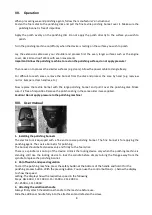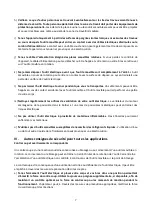
6
5) Service
a)
Have your electric tool repaired by qualified professionals using original replacement parts only.
This
guarantees that the safety of the electric tool is preserved.
III.
Safety instructions for all applications
General warnings for polishing
a)
This electric tool is intended for use as a polisher. Follow all warnings, instructions, illustrations and
data you have received with the device.
Failure to observe the following instructions can lead to
electric shock, fire and/or serious injury.
b)
This electric tool is not suitable for grinding, sandpaper grinding, working with steel brushes, abrasive
cutting.
Applications that deviate from the electric tool's intended use can cause hazards and injury.
c)
Only use accessory parts recommended and intended especially for this electric tool by the
manufacturer.
Unauthorized accessory parts that attach to your electric tool may still pose a safety risk.
d)
The permissible torque of insertion tools used must be at least as high as the maximum torque
indicated on the electric tool.
Accessory parts rotating in excess of their rate torque may be destroyed.
e)
The external diameter and width of insertion tools must match the specifications of your electric tool.
Incorrectly measured insertion tools cannot be sufficiently shrouded or controlled.
f)
In case the electric tool or insertion tool is dropped, check it for damages or use undamaged insertion
tools. After checking and attaching the insertion tool, keep the rotating insertion tool away from
yourself and persons in your vicinity and run the device for the duration of one minute at its highest
speed.
Damaged insertion tools will usually break during this test.
g)
Wear protective equipment while using the device. Depending on the task at hand, wear full face
protection, protective eyewear or protective goggles. Where necessary, where a dust mask, hearing
protection, protective gloves or a special apron to shield your person from small grinding/material
particles.
Shield your eyes against flying particles that develop by tasks of many kinds. A dust/respirator
mask should filter the dust that develops during use. You may suffer hearing loss if you are exposed to
high noise levels for too long a period.
h)
Make sure other persons present are at a safe distance from your working area. Any person that enter
your working area should wear personal protective gear.
Fragments of the work piece or broken
insertion tools may fly off and cause injury even outside the direct working area.
i)
Hold the device by the insulated handles only when carrying out tasks where the insertion tool may
come into contact with hidden power lines or its own power cable.
Contact with live wires may also
apply voltage to metallic device parts and result in electric shock.
j)
Keep the power cable away from rotating insertion tools.
If you lose control of the device, the power
cable may be severed or caught and your hand or arm may come into contact with the rotating insertion
tool.
k)
Never lay the electric tool aside before the insertion tool has come to a complete stop.
The rotating
insertion tool may come into contact with the surface and result in loss of control over the electric tool.
l)
Do not run the electric tool while carrying it.
Your clothing may come into accidental contact with the
rotating insertion tool and result in serious personal injury.
m)
Clean the electric tool's air vents regularly.
The motor fan draws dust into the housing and heavy
buildup of metal dust can pose an electrical hazard.
n)
Do not use the electric tool in the vicinity of combustible materials.
Sparks may cause the materials to
ignite.
o)
Do not use any insertion tools that require liquid coolants.
The use of water or other liquid coolants
may result in electric shock.
















































